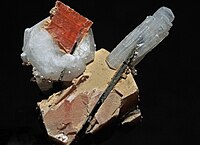
Photo from wikipedia
In order to determine the U-Pb crystallization age of zircon from the tourmaline-muscovite granites of the Kolmozero–Voronya greenstone belt located in the northeastern Fennoscandian Shield (Kola Peninsula), an isotope-geochronological study… Click to show full abstract
In order to determine the U-Pb crystallization age of zircon from the tourmaline-muscovite granites of the Kolmozero–Voronya greenstone belt located in the northeastern Fennoscandian Shield (Kola Peninsula), an isotope-geochronological study of the zircon grains was performed using a SHRIMP-RG microprobe. The belt is represented by the Archaean volcano-sedimentary rocks (2.9–2.8 Ga). Deposits of rare-metal pegmatites (Li and Cs with associated Nb, Ta, and Be) occur within the belt and on its margins. The age of the pegmatites within the belt was estimated at 2.7–2.6 Ga. Until now, there has been no generally accepted view on the genetic relation of the pegmatites with granite. Various authors have suggested that the pegmatites could potentially be associated with many type of granitoids within the region, i.e., plagiogranites, tonalites, amphibole-biotite granodiorites, microcline granites, alkaline granites, or muscovite-tourmaline granites. Zircon crystals from the muscovite-tourmaline granites are heterogeneous; they have less altered cores and strongly altered rims. The zircon cores are slightly enriched in U at a value of 173–1030 ppm, Th/U = 0.1–0.4. The zircons’ rims are heavily enriched in U at a value of 700–3300 ppm, Th/U = 0.03–0.08, indicating metasomatic processes. Zircon characteristics show that it crystallized from a melt enriched in a fluid phase. Fluid activity lasted after zircon crystallization as reflected in the irregular composition of the mineral and its rare earth element (REE) patterns that are typical of a metasomatic zircon. The computed zircon crystallization temperature in the tourmaline-muscovite granites is in the range of 650–850 °C. The discordant age calculated for five analyzed points of the zircon crystal cores is 2802 ± 13 Ma. The discordant age for four analyzed points of the zircon crystal rims is found to be 2728 ± 14 Ma. On the basis of the obtained isotope-geochronological data, we conclude that the tourmaline-muscovite granites located in the immediate vicinity of rare-metal pegmatite veins are the most probable source of matter for the pegmatites.
Journal Title: Minerals
Year Published: 2020
Link to full text (if available)
Share on Social Media: Sign Up to like & get
recommendations!